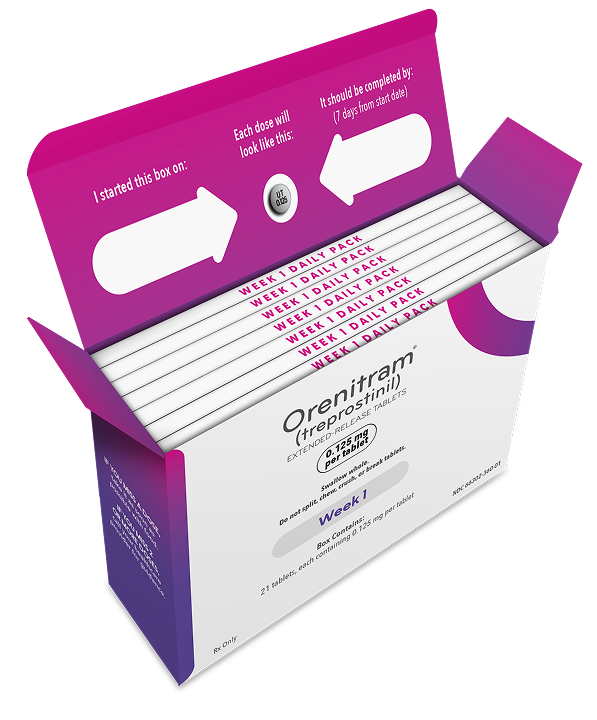Assess RISK.
Consider TIME.
Leverage ORENITRAM.
Reaching an initial target TDD of ≥9 mg is important to achieving clinical improvement, but individual patient needs may vary.1,2 Selecting the appropriate dosing approach may help you and your patients reach this goal.
Dosing with Orenitram
5 Tablet Strengths for Flexible Dosing
Multiple tablet strengths provide dosing flexibility to meet your patient’s unique clinical needs, and allows them to continue to titrate to reach maximum clinical benefit.1*





Tablets are not shown to actual size.
*Maximum labeled dose for Orenitram is 120 mg TDD.1
Optimizing Treatment Through Flexible Dosing with Orenitram
Discover how flexible dosing with Orenitram can help address the evolving needs of intermediate risk PAH patients. This video highlights the importance of dose-response in optimizing risk parameters before patients progress further.2
Support a TID dosing schedule
Orenitram is best tolerated TID every 8 hours with food, as this may help to reduce peak-to-trough fluctuations.1
Breakfast
(6A-8A)
8 HOURS
Afternoon Snack
(2P-4P)
8 HOURS
Bedtime Snack
(10P-12A)
Choose the Appropriate Dosing Approach for Your Patients’ Clinical Needs
Reaching a therapeutic dose is important to achieving clinical improvement, but individual patient needs may vary based on1 :
RISK
assessment
TIME needed to reach necessary exposure
DOSING PREFERENCE to achieve goals
Select a Dosing Approach for Prostacyclin-Naïve Patients2:
- For lower risk patients with less severe disease, initiate Orenitram at a low dose with slow up-titration to manage side effects

The Orenitram Titration Kit
An all-in-one kit helps simplify titration and build confidence as patients reach necessary exposure1
See How It Works- For higher risk patients, consider parenteral therapy. If and when appropriate, transition to a comparable dose of Orenitram†
†Transition may be appropriate for hemodynamically stable patients.
Transitioning Appropriate Prostacyclin-Experienced Patients2:

Transitioning From Remodulin to Orenitram
For hemodynamically stable patients, an established plan to transition from Remodulin® (treprostinil) Injection to Orenitram
See the StudyFor patients on current therapy, evidence from a peer-reviewed article supports that patients who have reached dose limits or are at risk for discontinuation due to tolerability might be candidates for Orenitram2

Did you know that eligible patients may start treatment on the Orenitram Titration Kit at no cost for up to 90 days?
Learn MoreEvolution of Orenitram: Dosing and Patient Management6-13
2012
- 2013
STUDIES & PUBLICATIONS
FREEDOM-C† (N=350) 16-week
- Initiated at 0.5 mg BID, increased by 0.5 mg BID every 3 days
FREEDOM-M (N=349) 12-week
- Initiated at 0.25 mg BID, increased by 0.25 or 0.5 mg BID every 3 days
FREEDOM-C2† (N=310) 16-week
- Initiated at 0.25 mg BID, increased by 0.25 mg BID every 3 days
DOSING (MG TDD)‡
LEARNINGS
2014
STUDIES & PUBLICATIONS
REAL-WORLD CLINICAL SETTING (N=1200) 78-week
DOSING (MG TDD)‡
LEARNINGS
Meal-Enhanced Absorption14
2017
STUDIES & PUBLICATIONS
TRANSITION STUDY (N=33) 24-week
DOSING (MG TDD)‡
LEARNINGS
Stable Transition from Remodulin, Expert AE Management Consensus
2019
STUDIES & PUBLICATIONS
FREEDOM-EV† (N=690) 48-week
- Initiated at 0.125 mg TID, increased by 0.125 mg every day for 4 weeks and 0.25 mg thereafter, to a maximum dose of 12 mg
DOSING (MG TDD)‡
LEARNINGS
TID Preferred
2022
STUDIES & PUBLICATIONS
FREEDOM-EV HEMODYNAMIC SUBSTUDY (N=61) 24-week
DOSING (MG TDD)‡
LEARNINGS
Hemodynamic effects of Orenitram
2024
STUDIES & PUBLICATIONS
FREEDOM-EV OLE (N=470) 48-week||
DOSING (MG TDD)‡
LEARNINGS
9 mg Initial Target TDD;2
1st, 2nd-line, Refractory AE Management Published;2
Every patient is different.
11.5 mg
Real World average TDD of Orenitram at 3 months
Based on Specialty Pharmacy shipment data through May 2025 inclusive of de novo and transition patients.4
"There’s been a learning curve [with Orenitram] and the more recent studies have shown that we’re learning how to use it better"
— PAH expert
‡In FREEDOM-C, median dose of 3 mg BID is from week 16.8 In FREEDOM-M, Orenitram was first initiated at 1 mg. After study protocol revisions, the starting dosage was changed to 0.5 mg, then, 0.25 mg. Mean dose of 3.4 mg BID is from week 12.9 In FREEDOM-C2, mean dose of 3.1 mg BID is from week 16.10 In Real-World Clinical Setting, median dose of 10.8 mg TDD at month 18 is from medication shipment records of a representative sample of patients taking Orenitram TID.11 In the Transition Study, subjects were administered Orenitram TID while simultaneously decreasing the Remodulin dose (from a baseline Remodulin dose of 57 ng/kg/min). Mean dose of 39.5 mg TDD is from week 24.7 In FREEDOM-EV, median dose of 3.56 mg TID is from week 24.6 In the FREEDOM-EV hemodynamic substudy, median dose of 5.5 mg TID is from week 24.12 In FREEDOM-EV OLE, patients initially randomized to Orenitram continued at their previous dose and were able to titrate further without limitation. These patients reached a mean dose of 6.1 mg TID 48 weeks after enrollment in the OLE.13
§These trials did not achieve significance for their respective primary endpoints.8,10
||Indicated time points show when mean/median doses were measured. Event-driven study duration was not predefined.
Dosing and AE Management as a Team
Franck Rahaghi, MD, and Starlet Harrimon, RN, discuss how they work with patients to plan for expected adverse effects with Orenitram.
United Therapeutics does not provide medical advice. Adverse effect management strategies should be addressed in accordance with the Orenitram Full Prescribing Information and your clinical judgment.
Frequently Asked Questions
United Therapeutics does not provide medical advice. Adverse event management or dosing strategies should be dealt with in accordance with the Orenitram Full Prescribing Information and your clinical judgment.